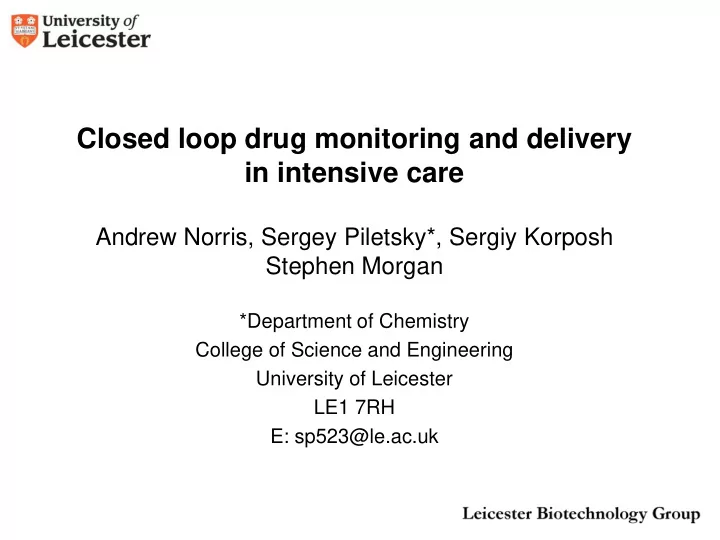

Closed loop drug monitoring and delivery in intensive care Andrew Norris, Sergey Piletsky*, Sergiy Korposh Stephen Morgan *Department of Chemistry College of Science and Engineering University of Leicester LE1 7RH E: sp523@le.ac.uk
Aim and objectives The aim of this 6 months project is to produce a closed loop control system in which key pharmacological and physiological parameters are monitored in real time and the drug dose altered automatically to optimise patient treatment. The main objectives are: 1. Synthesis of nanoMIPs for relevant targets (fentanyl, propofol and midazolam); 2. Integration of MIPs with optical fibres (long period grating - OFS); 3. Testing of sensor performance in model samples.
Solid-phase synthesis of nano-MIPs ACN 60°C ACN, 0°C UV UV UV UV
Synthesiser for MIP nanoparticles Automatic reactor for MIP nanoparticles • Manufacturing cycle – 3.5 hours • Yield – 50 mg (can be scaled up)
Comparison of MIPs and antibodies in ELISA Template MIP size, nm Detecion limit for assay Detection limit in assay with with MIP, nM antibodies, nM 1.20x10 -3 2.54x10 -3 Biotin 104±6 8.07x10 -3 L-Thyroxine 164±11 17.5 Glucosamine 138±16 4.01x10 -4 3.38x10 -4 Fumonisin B2 94±4 6.12x10 -3 2.5x10 -2 Haemoglobin 149±15 8.7x10 -2 1.54x10 -4 Glycated 103±14 2.46x10 -3 - haemoglobin (“polyclonal”) 9.49x10 -3 2.38x10 -4 Glycated 103±14 haemoglobin (“monoclonal”)* *In contrast to antibodies, ”monoclonal” MIPs had no cross -reactivity for non-glycated haemoglobin
Targets and derivatives
Synthesis of fentanyl derivative (73%) (67%) (32%) Reaction1: Valdez, C.A.; Leif, R.N.; Mayer, B.P. PLOS ONE , 2014, 9 , e108250 Reactions 2 & 3: Bremer, P.T. et al., Angew. Chem. Int. Ed. 2016, 55 , 3772-3775 (supporting information).
Synthesis of propofol derivative (~24%) (70%) Reaction 1: Adapted from: Pepperberg, D.R. et al., US20130237899A1, Sept 12 2013, p40 Reaction 2: Stewart, D.S . et al., J. Med. Chem. 2011, 54 , 8124-8135.
Molecular design of nanoMIPs for propofol Selection of monomers based on LEAPFROG Functional monomer Binding energy, kcal/mol Acrylamide -26.38 TFMAA -16.29 Itaconic acid -14.96 Methacrylic acid -13.63 Vinylimidazole -6.32 Allows rapid ‘dialling’ and optimisation of nanoMIPs. Leads to the selection of monomers displaying strong affinity for the template for polymer preparation.
Molecular design of nanoMIPs for fentanyl Functional monomers Binding energy, kcal/mol MBAA -29.77 Acrylamide -25.66 Methacrylic acid -17.19 Itaconic acid -16.38 EGMP -16.29 HEM -14.23 Composition of the nanoMIPs for fentanyl made in organics: Functional monomers: MAA, HEM, styrene, TFMAA Cross-linkers: EGDMA, TRIM PETMP, iniferter, fluorescein Solvent: acetonitrile
Solid phase synthesis of nanoMIPs • Immobilisation of propofol derivative onto solid phase (glass beads) • Preparation of propofol-specific nanoMIPs in water using 30 g of glass beads with immobilised propofol Monomeric mixture: 19.5 mg of N -isopropylacrylamide (NIPAm) 3 mg of N,N’ -methylene-bisacrylamide (MBAA) 15 mg of N -tert-butylacrylamide (TBAm) dissolved in ethanol 50 µL of the solution of 22 mg/mL of acrylic acid in water 3 mg of 3-aminopropyl methacrylate 3 mg of polymerisable rhodamine 50 mL of phosphate buffered saline (PBS) Initiator: 12 mg of potassium persulfate and 6 μ L of TEMED in 400 μ L of water • Deoxygenation by purging with N 2 for 20 min • Chemical polymerisation for 1 h • Washing of unreacted monomers and low affinity nanoparticles • Elution of high affinity nanoparticles using hot water • Dialysis of high affinity nanoparticles and their characterisation using DLS
OFS functionalisation 1.0 Transmission (a.u.) Water before MIPs Water after MIPs 0.8 0.6 R-LP 019 : 873.7- 874.44 L-LP 019 : 768.06- 767.56 0.4 750 800 850 900 Wavelength (nm) The attachment of MIPs on Optical fibre can be confirmed by the shift of wavelength (1.24 nm in total). However, the dynamic binding of MIPs cannot be observed
Fentanyl detection Water 5 ng/ml 10 ng/ml 1.0 Transmission (a.u.) 0.8 0.6 R-LP 019 L-LP 019 L-LP 019 L-LP 019 0.4 750 800 850 900 Wavelength (nm) Fentanyl power was dissolved into distilled water with concentration range from 5 ng/ml to 1 mg/ml. LPG sensor was initially tested with blank sample ( distilled water for 4 times in order to evaluate the sample infusion error and turns out the infusion error can be neglected ) then subsequently immerse the sensor into different concentration of fentanyl solution from a low to high order with three times washing with distilled water between each concentration. Room temperature during test : 26.98 ± 0.14 ℃
Future work • Optimisation of sensor performance for fentanyl and propofol detection in spiked samples; • Analysis of detection limit and specificity of sensor response; • Analysis of sensor regeneration conditions; • Testing of sensor performance over 3 months period.
Recommend
More recommend